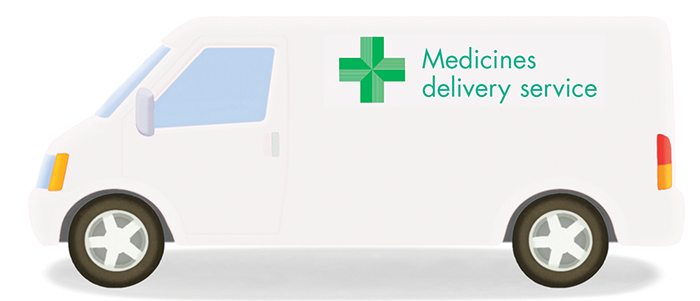Delivering the goods
In Running Your Business
Follow this topic
Bookmark
Record learning outcomes
 Offering a medicines delivery service from your pharmacy is a huge benefit to many of your customers and creates a valuable point of difference for your business, so how do you go about setting one up, and how much will it cost?
Offering a medicines delivery service from your pharmacy is a huge benefit to many of your customers and creates a valuable point of difference for your business, so how do you go about setting one up, and how much will it cost?
Community pharmacy is well known for going the extra mile to help customers get the care and medication they need, and delivering medicines to their doorstep takes that philosophy to its logical conclusion.
Pharmacies that offer this service collect patients' NHS or private prescriptions from their GP before dispensing and dispatching their medicines, most often for free. This is extremely convenient for customers without transport or who find it hard to get around, as well as older people €“ the majority of healthcare users. It is also ideal for those on regular repeat medication. A well-run service can ensure that customers' next lot of medicine arrives before their current prescription runs out.
Rules and regulations
As you would expect, there are guidelines for pharmacy businesses that offer this kind of service. The GPhC Guidance for registered pharmacies providing pharmacy services at a distance (pharmacyregulation.org) covers those offering €a delivery service from the registered pharmacy to patients in their own home or in a care home or nursing home€ and draws attention to a number of points. Including that if you offer a delivery service, the handover to the delivery agent of a P or POM medicine must take place at a registered pharmacy under the supervision of a pharmacist.
When medicines are not given to the patient in the registered pharmacy, but are delivered by a member of staff or an agent to the patient's home or workplace, even if you contract out any part of your pharmacy service to a third party, you are still responsible for providing it safely and effectively and must carry out €due diligence€ in selecting any contractors.
The guidelines also stress that medicines must be supplied safely, which includes, among other things, assessing the suitability and timescale of the method of supply, dispatch, and delivery; the suitability of packaging; and the terms, conditions and restrictions of the carrier. In addition, you should consider how staff can communicate any important information to patients clearly and effectively when they are not seeing someone face to face, and give clear information on how they can contact your pharmacy staff if they have any problems or need more advice. This should also include advice on when they should go back to their GP or local pharmacist.
This clearly means extra work for everyone involved €“ for which no funding is provided €“ and attention to detail, so what are the main drivers behind deciding to offer a delivery service?
€There are lots of reasons, but it is mainly about convenience to the general public and the people who really need it,€ says Umesh Patel, NPA board member and owner of Leema Pharmacy in Sunderland. €Our older customers can't always come to collect their medicines, along with expectant and young mothers, so it is much more convenient for us to collect their prescriptions from the surgery, and it saves time for doctors.€
How to start
Mr Patel admits that it was €difficult€ setting up the service. €You need authorisation from the patient, then you have to take the paperwork to the surgery because they need proof you are offering the service rather than poaching prescriptions from other pharmacies,€ he says. €Then you have to log whether prescriptions are repeats, and you need to look at the cycle of the prescriptions as some might fall at the end of month and some at other times. Once that's done, the list comes out and you can draw up a map for the day of delivery that your driver can follow, but at the same time there is also the collection to be picked up from the surgery, which has to be timed properly as well. It's a bit of a triangle.€
Once the service is in place Mr Patel says it €runs more smoothly and you get to grips with what you are doing€. He suggests asking the LPC for help if you want to know more about how to run the process, and that sharing information with other contractors and members is very helpful.
Delivery drivers
Kamsons Pharmacy, a nationwide chain with 56 branches, has delivered medicines to people at home since it started out in 1979. €A prescription delivery service has always been an important part of the service we offer our customers,€ says operations manager Paul Antenen, €although back in those days it would have been the pharmacist delivering after work.€
Today all 56 pharmacies have at least one delivery driver, whom Mr Antenen describes as €such an important part of the pharmacy team now, [because they are] sometimes the main point of contact that many of our customers have with the pharmacy.€
It's not just customers the drivers are interacting with. €Delivering items is not the only part of the driver's job,€ says Mr Patel. €He or she will also be expected to collect prescriptions from GPs and so will have to build good relationships with surgeries, which are not always co-operative. This can be one of the more frustrating aspects of the job, with a number of surgeries not treating prescription preparation with any urgency, meaning that the driver might arrive to find that an essential prescription is not ready, or that it has been done at a sister surgery some distance away.€
This is where the pharmacist can help €by doing his or her bit to make connections with surgery administrators€, he says. €The relationship gets better if you work not just with GPs, but with the managers who work there. I have talked with my local health centre and my relationship with them is very good.€
Considering costs
Unsurprisingly, being able to run this kind of service comes at a price. Kamsons owns more than 50 delivery vehicles and, with all the associated maintenance and running expenses, Mr Antenen says the costs €are not inconsiderable. The wage bill also runs into tens of thousands of pounds and none of this is funded by the NHS, something that needs to be considered in light of impending cuts.€
Mr Patel agrees that more could be done by the government to support pharmacists who provide a delivery service. €This service should be funded, but in the current economic climate, it is very difficult because the government wants more for less,€ he says.
€I started to offer deliveries because the market demand was clear. I do on average about 50 deliveries a week, but it is inappropriate for any pharmacist to charge for delivery €“ it is part of the service to the patient. We have to cover the cost of the van, the fuel and the specialist driver, which can add up to a significant figure, on top of which there is the driver's wages and insurance. A delivery service is a loss leader, but at the end of the day we are here to satisfy the needs of our customers and patients so as far as we are concerned it is definitely worth doing.€
Pros and cons
On the plus side, there are advantages for any business that can operate a successful delivery service. Mr Antenen says customers love the service and over the years it has given Kamsons €a considerable competitive advantage€. He says: €There is no question that it has driven items' growth and we have been rewarded with loyalty. Customers hate it when something is out of stock, but if you offer to deliver it for free, they are often very grateful.
It is also great for surgery relationships when you can respond with an emergency delivery at the end of a day. It is almost an expected part of the service now, but we still find that we can be more flexible with our delivery times and are able to respond to last minute requests more readily than some of our competitors. The branded vans and uniformed drivers are also a form of mobile advertising.€

He admits, however, that €the fact that we don't have the customer visiting the pharmacy in person can make providing services more difficult, for example MURs and NMS€. And while Mr Patel stresses that €medication delivery services do not bring in any extra income for community pharmacy€, he is adamant that they are €undoubtedly valuable to patients, particularly those who are too frail or ill to collect their prescriptions, and for products that are too bulky to transport simply.
€In the end,€ he says, €it is all about offering satisfaction to the patient, and the cost is immaterial. When it comes to deliveries I think independents and multiples can be just as efficient as the Amazons of this world, and community pharmacy has the added bonus that we actually know our customers in person.€
See Noel Wicks' column for more on this topic
We have to cover the costs of the van, the fuel and the specialist driver, which can add up to a significant figure. A delivery service is a loss leader
Benefits of home delivery to the housebound
 Roger Mitchell is managing director of the Wessex Pharmacies group in Dorset.
Roger Mitchell is managing director of the Wessex Pharmacies group in Dorset.
€We provide vital healthcare and advice to people in our local communities, making sure that patients get their medicines and know how to take them. Our customers know they can pop in and see a healthcare professional, without an appointment, at a time to suit them, but we also deliver medicines to their homes free of charge.€
€For example, our driver, Tony, makes 35 to 50 deliveries a day to patients' homes. We know that for some people at home, he is the only face-to-face contact they have with anyone from one week to another. Our team of drivers have an important role in helping our patients to maintain their independence and live at home for as long as possible.€
But the cost of the delivery service is €significant€, he says. And less pharmacy funding could mean reconsidering the service. €The delivery service is mostly there for patients who aren't able to get to the pharmacy themselves, but others do use it too. Occasionally we find someone isn't home when we deliver, only to hear later that they were out at Sainsbury's (just next door to the pharmacy), and wonder if this is something we can afford to maintain. But we would never stop deliveries for people who can't get out of the house. It's too important.€
